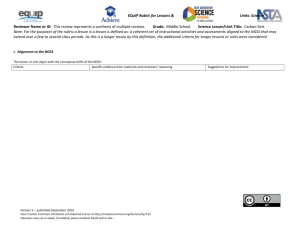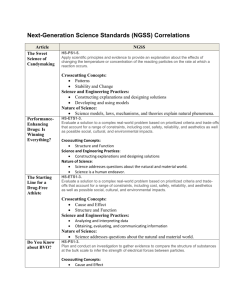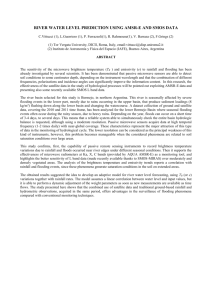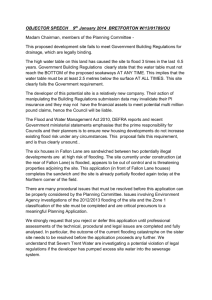Floodplain Modeling EQuIP Rubric Combined
advertisement
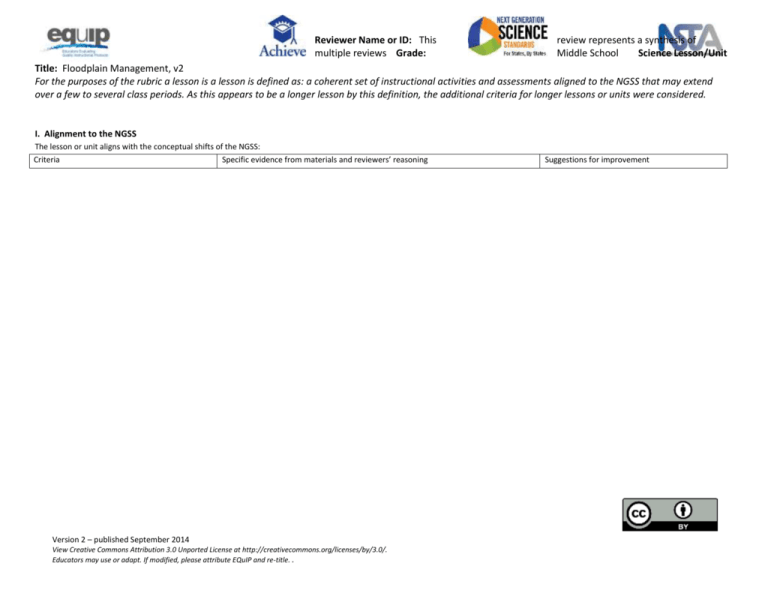
Reviewer Name or ID: This multiple reviews Grade: review represents a synthesis of Middle School Science Lesson/Unit Title: Floodplain Management, v2 For the purposes of the rubric a lesson is a lesson is defined as: a coherent set of instructional activities and assessments aligned to the NGSS that may extend over a few to several class periods. As this appears to be a longer lesson by this definition, the additional criteria for longer lessons or units were considered. I. Alignment to the NGSS The lesson or unit aligns with the conceptual shifts of the NGSS: Criteria Specific evidence from materials and reviewers’ reasoning Version 2 – published September 2014 View Creative Commons Attribution 3.0 Unported License at http://creativecommons.org/licenses/by/3.0/. Educators may use or adapt. If modified, please attribute EQuIP and re-title. . Suggestions for improvement EQuIP Rubric for Lessons & Units: Science A. Grade-appropriate elements of the science and engineering practice(s), disciplinary core idea(s), and crosscutting concept(s), work together to support students in threedimensional learning to make sense of phenomena and/or to design solutions to problems. i. Provides opportunities to develop and use specific elements of the practice(s) to make sense of phenomena and/or to design solutions to problems. ii. Provides opportunities to develop and use specific elements of the disciplinary core idea(s) to make sense of phenomena and/or to design solutions to problems. iii. Provides opportunities to develop and use specific elements of the crosscutting concept(s) to make sense of phenomena and/or to design solutions to problems. iv. The three dimensions work together to support students to make sense of phenomena and/or to design solutions to problems. i. Evidence of opportunities for students to develop and use the practices include: Students generate questions as part of a KWL (page 3). Students return to this question generation after the close reading activity with text and KWL (page 4). This question generation/text analysis leads to students asking questions to determine relationships between independent and dependent variables and relationships in models. (Appendix F). Students then use SEP 2 (Models) to “use a physical model as a tool to test three riverbed models to compare (CCC patterns) normal water flow conditions and hundred-year water flow conditions (Part 2). Students are using a model to predict and describe phenomena. (appendix F) The understanding gained using SEP 2 (shape, size, river flow) from analyzing and interpreting data SEP 4 is used as evidence in an argument using the language of the practice construct an argument supported by empirical evidence and scientific reasoning to support a model for a phenomenon. (Appendix F). ii. Evidence of opportunities for students to develop and use the DCIs include: The DCI (ESS3.B) specifically calls for the “mapping of the history of natural hazards in a region and that history be combined with an understanding of related geologic forces,” neither of which is evidenced in this lesson. Student do not address most of the listed DCI ESS2.C, with the exception of “downhill flow” when they discuss how to position their model. PS3.A is not explicit in this lesson. It seems as though it is intended as background knowledge based on the “Notes on Instructional Sequence,” but it is not clear. The lesson does give students the opportunity to address, “the forecasting of locations and likelihood of natural events” through the use of models as it applies to the natural disaster of flooding. iii. Evidence of opportunities for students to develop and use the CCC include: Students are using models (SEP) to generate data about river shape, size and flow. However, they are not explicitly addressing how these models represent systems. Students are looking for patterns in their data on page 6, when posed with questions like: Do they notice any patterns of trends in data? Are there any anomalies? These questions support students using the CCC patterns to understand the natural disaster of flooding so they can develop a proposal to mitigate the effects of flooding. iv. Students are using models to gather data (practice) and look for patterns (CCC) about the shape, size and flow of a river to understand the natural disaster of flooding (DCI). Students use the data they collected to help them predict the location of flooding in a different context and identify ways to mitigate effects of flooding (DCI). There are more opportunities that should be taken advantage of to ask students to consider why they are developing the model in the way that they are (so that they better understand what it is designed to represent) as well as the limitations of their models and models used by scientists and engineers. Similarly students should have opportunities to think more about the data they are collecting including: thinking about what kind of data they need and why before collecting it, whether the data collected supports their predictions, etc. Consider including the other elements of DCI ESS3.B – the students could examine maps of a local watershed, satellite images, etc. over time including during flooding. The other DCI elements that were not thoroughly addressed should either be removed, included in a more robust way, or clearly designated as background knowledge. While students are developing and using model, and systems are implicit in this lesson, students should have the opportunity to explicitly connect how their models are allowing them to study a particular system to better get at the listed element of the CCC. A unit or longer lesson will also: Criteria Specific evidence from materials and reviewers’ reasoning Suggestions for improvement B. Lessons fit together coherently targeting a set of performance expectations. i. Each lesson links to previous lessons and provides a The observation of the phenomenon of flooding and the record of the developing understanding on the KWL ties the parts of the lesson together. Students need to gain an understanding flood and its effects to engage in the Bundle this PE with others or make notations on how this lesson series can be part of a bigger unit and learning sequence. Version 2 – published September 2014 View Creative Commons Attribution 3.0 Unported License at http://creativecommons.org/licenses/by/3.0/. Educators may use or adapt. If modified, please attribute EQuIP and re-title. EQuIP Rubric for Lessons & Units: Science need to engage in the current lesson. ii. The lessons help students develop proficiency on a targeted set of performance expectations. problem posed in part one. The teacher guides discussion that highlights a piece of text evidence in the KWL discussion “highly advanced computer modeling now let’s disaster authorities predict with amazing accuracy where floods will occur and how severe they’re likely to be” (page 4). This links part one and part two, giving students a reason to use the physical models to understand and predict flooding. In part three, students use the understanding about flooding and flood plains to “mitigate future flooding effects” in their proposals. This lesson identifies a PE (MS-ESS3-2) that is targeted, not a targeted set of PE’s. On page 1, DCIs which are associated with other PE’s are identified, presumably as previous understanding. While students discuss how to mitigate the effects of floods (MS-ESS3-2), they do not necessarily address the development of new technologies. The development of new technologies should either be included or it should be noted that it is not included. It might be helpful to note during the course of the lesson that analyzing and interpreting data about natural hazards including mapping their history, etc. can be helpful in predicting natural disasters beyond floods. C. Where appropriate, disciplinary core ideas from different disciplines are used together to explain phenomena. DCI PS3.A is listed, presumably as a previous understanding for these students that they will bring in to the lesson. The use of the DCI within the lesson is implied at best. The lesson should be more explicit in providing supports for using PS3.A in the explanation of the flood plain and the flood management task. D. Where appropriate, crosscutting concepts are used in the explanation of phenomena from a variety of disciplines. The opportunity exists to use the crosscutting of systems and system models to connect earth systems to physical science ideas that were listed (like PS3.A – A system of objects may also contain stored (potential) energy, depending on their relative positions.) However, this connection was not made, at least not explicitly. Provide supports for the teacher to support students in using the crosscutting concepts of system and system models to understand the flood plain context using both ESS and PS domains. E. Provides grade-appropriate connection(s) to the Common Core State Standards in Mathematics and/or English Language Arts & Literacy in History/Social Studies, Science and Technical Subjects. Students are asked to read the National Geographic article, or another article, discuss it, and use it to update KWL chart. (RST.6-8.2 – Determine the central ideas or conclusions of a text; provide an accurate summary of the text distinct from prior knowledge or opinions.) II. Instructional Supports The lesson or unit supports instruction and learning for all students: Criteria Specific evidence from materials and reviewers’ reasoning Version 2 – published September 2014 View Creative Commons Attribution 3.0 Unported License at http://creativecommons.org/licenses/by/3.0/. Educators may use or adapt. If modified, please attribute EQuIP and re-title. Suggestions for improvement EQuIP Rubric for Lessons & Units: Science A. Engages students in authentic and meaningful scenarios that reflect the practice of science and engineering as experienced in the real world and that provide students with a purpose (e.g., making sense of phenomena and/or designing solutions to problems). i. The context, including phenomena, questions, or problems, motivates students to engage in three-dimensional learning. ii. Provides students with relevant phenomena (either firsthand experiences or through representations) to make sense of and/or relevant problems to solve. iii. Engages students in multiple practices that work together with disciplinary core ideas and crosscutting concepts to support students in making sense of phenomena and/or designing solutions to problems. iv. Provides opportunities for students to connect their explanation of a phenomenon and/or their design solution to a problem to their own experience. v. When engineering performance expectations are included, they are used along with disciplinary core ideas from physical, life, or earth and space sciences. B. Develops deeper understanding of the practices, disciplinary core ideas, and crosscutting concepts by identifying and building on students’ prior knowledge. C. Uses scientifically accurate and grade-appropriate scientific information, phenomena, and representations to support students’ three-dimensional learning. D. Provides opportunities for students to express, clarify, justify, interpret, and represent their ideas and respond to peer and teacher feedback orally and/or in written form as appropriate to support student’s three-dimensional learning. E. Provides guidance for teachers to support differentiated instruction in the classroom so that every student’s needs are addressed by including: i. Suggestions for how to connect instruction to the students' home, neighborhood, community and/or culture as appropriate. ii. Appropriate reading, writing, listening, and/or speaking alternatives (e.g., translations, picture support, graphic organizers) for students who are English language learners, have special needs, or read well below the grade level. iii. Suggested extra support (e.g., phenomena, representations, tasks) for students who are struggling to meet the performance i. “No other natural disaster in America has caused more death and destruction that floods,” National Geographic Floods 101. This quote from the video included in lesson materials is evidence of a real-life context to engage learners. The article makes it clear that there are few places where people do not need to be aware of flooding. ii. The phenomena of flooding is relevant because of the effect that it has on people, and possibly the effect it has had directly on students. Student have an opportunity to engage firsthand with the phenomena through a simulation. iii. Students have opportunities to use multiple practices including modeling and obtaining information. iv. The opening of the lesson asks students to connect to their home or community by asking for experience with flooding. If students do not have a personal connection via experience, a video is provided to connect instruction to learner. v. Engineering PEs are not included. Student’s prior knowledge may depend on their region and experience with flooding. Opportunities exist for students to dig deeper using models to understand the natural disaster of flooding after connecting with prior knowledge of the context. It may also be the case that students are expected to have prior knowledge of the role of water in Earth’s surface processes (ESS2.C) though it is not clear and not explicitly tapped. Most of the information provided, as well as the phenomena and representations, are grade appropriate and accurate. However the Lexile level of the National Geographic article is above a middle school level. See more in II.E. Students provided with multiple opportunities to express ideas as part of the class discussion to create the KWL and encouraged to offer evidence to support their claims (on page 4). Students represent their ideas and predictions in “engineering sketches” (page 5). i. The opening of the lesson asks students to connect to their home or community by asking for experience with flooding. If students do not have a personal connection via experience, a video is provided to connect instruction to learner. ii.–iii. There are suggested strategies for accessing the National Geographic article, which is especially important due to its high Lexile level on page 4 as well as a video alternative on page 13. iv. There are a variety of extension activities on page 13. Version 2 – published September 2014 View Creative Commons Attribution 3.0 Unported License at http://creativecommons.org/licenses/by/3.0/. Educators may use or adapt. If modified, please attribute EQuIP and re-title. The Lexile level for the National Geographic article is 1290 which is in the grade 9–12 range, above middle school level. Middleschool-level reading alternatives may be appropriate to include. EQuIP Rubric for Lessons & Units: Science expectations. iv. Extensions for students with high interest or who have already met the performance expectations to develop deeper understanding of the practices, disciplinary core ideas, and crosscutting concepts. A unit or longer lesson will also: Criteria Specific evidence from materials and reviewers’ reasoning F. Provides guidance for teachers throughout the unit for how lessons build on each other to support students developing deeper understanding of the practices, disciplinary core ideas, and crosscutting concepts over the course of the unit. There is guidance provided for teachers on how to support students’ use of patterns to make sense of the observations of the multiple models to gain an understanding of a floodplain so students can mitigate the effects of flood damage to buildings in a floodplain during a flood in later parts of the lesson. G. Provides supports to help students engage in the practices as needed and gradually adjusts supports over time so that students are increasingly responsible for making sense of phenomena and/or designing solutions to problems. Lesson sequence not long enough to provide evidence. Suggestions for improvement III. Monitoring Student Progress The lesson or unit supports monitoring student progress: Criteria Specific evidence from materials and reviewers’ reasoning Suggestions for improvement A. Elicits direct, observable evidence of threedimensional learning by students using practices with core ideas and crosscutting concepts to make sense of phenomena and/or to design solutions. The lesson provides an opportunities to elicit observable evidence of students’ ability to analyzing data and use patterns to understand a natural disaster (flooding) and to use models to make predictions in order to mitigate effects. B. Formative assessments of three-dimensional learning are embedded throughout the instruction. An opportunity for formative assessment of students’ understanding of the natural disaster of flooding exists when students revisit their KWL chart during their “after reading” discussion (page 4). The engineering sketches students create can be used as a formative assessment as they provide evidence of being able to use models as well as elements of DCIs. C. Includes aligned rubrics and scoring guidelines that provide guidance for interpreting student performance along the three dimensions to support teachers in (a) planning instruction and Students are also encouraged to look for patterns in data and patterns and shares in class discussions. The performance task rubric includes elements of DCIs and the use of evidence in communication. The rubric for the engineering sketch addresses components of the model but not relationships between the components explicitly or limitations of the model. Version 2 – published September 2014 View Creative Commons Attribution 3.0 Unported License at http://creativecommons.org/licenses/by/3.0/. Educators may use or adapt. If modified, please attribute EQuIP and re-title. Add criteria of the practices and crosscutting concepts to the rubrics to better support three-dimensional evidence of learning and feedback support. EQuIP Rubric for Lessons & Units: Science (b) providing ongoing feedback to students. Firsthand experience of model building and using models for prediction to understand flooding is accessible to students. Criteria Specific evidence from materials and reviewers’ reasoning Suggestions for improvement E. Includes pre-, formative, summative, and selfassessment measures that assess threedimensional learning. Evidence of summative and formative assessments can be found above. Consider including a pre-assessment of the DCI’s (ESS2.C and PS3.A) and of the practices and CCCs to determine student understanding. F. Provides multiple opportunities for students to demonstrate performance of practices connected with their understanding of disciplinary core ideas and crosscutting concepts and receive feedback. The lesson is not long enough for evidence. D. Assessing student proficiency using methods, vocabulary, representations, and examples that are accessible and unbiased for all students. A unit or longer lesson will also: Overall Summary Comments: Version 2 – published September 2014 View Creative Commons Attribution 3.0 Unported License at http://creativecommons.org/licenses/by/3.0/. Educators may use or adapt. If modified, please attribute EQuIP and re-title.
